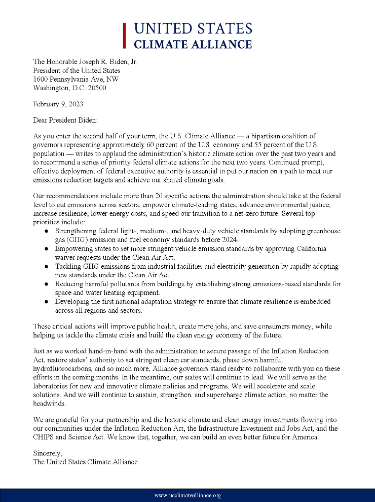Home / U.S. Climate Alliance Recommends Federal Executive Actions to Speed America’s Net-Zero Transition

Tags
- Letter
U.S. Climate Alliance Recommends Federal Executive Actions to Speed America’s Net-Zero Transition
February 9, 2023
Continued prompt, effective deployment of federal executive authority is essential to put our nation on a path to meet our emissions reduction targets and achieve our shared climate goals.
Our recommendations include more than 20 specific actions the administration should take at the federal level to cut emissions across sectors, empower climate-leading states, advance environmental justice, increase resilience, lower energy costs, and speed our transition to a net-zero future. Several top priorities include:
- Strengthening federal light-, medium-, and heavy-duty vehicle standards by adopting greenhouse gas (GHG) emission and fuel economy standards before 2024.
- Empowering states to set more stringent vehicle emission standards by approving California waiver requests under the Clean Air Act.
- Tackling GHG emissions from industrial facilities and electricity generation by rapidly adopting new standards under the Clean Air Act.
- Reducing harmful pollutants from buildings by establishing strong emissions-based standards for space and water heating equipment.
- Developing the first national adaptation strategy to ensure that climate resilience is embedded across all regions and sectors.
These critical actions will improve public health, create more jobs, and save consumers money, while helping us tackle the climate crisis and build the clean energy economy of the future.
About the Alliance
Launched in 2017 by the governors of Washington, New York, and California to help fill the void left by the U.S. federal government’s withdrawal from the Paris Agreement, the Alliance has grown to include 24 governors from across the U.S. representing approximately 60 percent of the U.S. economy and 55 percent of the U.S. population. Governors in the Alliance have pledged to collectively reduce net greenhouse gas emissions by at least 26-28 percent by 2025, 50-52 percent by 2030, and 61-66 percent by 2035, all below 2005 levels, and collectively achieve overall net-zero greenhouse gas emissions as soon as practicable, and no later than 2050.
The Alliance’s states and territories continue to advance innovative and impactful climate solutions to grow the economy, create jobs, and protect public health, and have a long record of action and results. In fact, the latest data shows that as of 2023, the Alliance has reduced its collective net greenhouse gas emissions by 24 percent below 2005 levels, while increasing collective GDP by 34 percent, and is on track to meet its near-term climate goal of reducing collective greenhouse gas emissions 26 percent below 2005 levels by 2025.
###